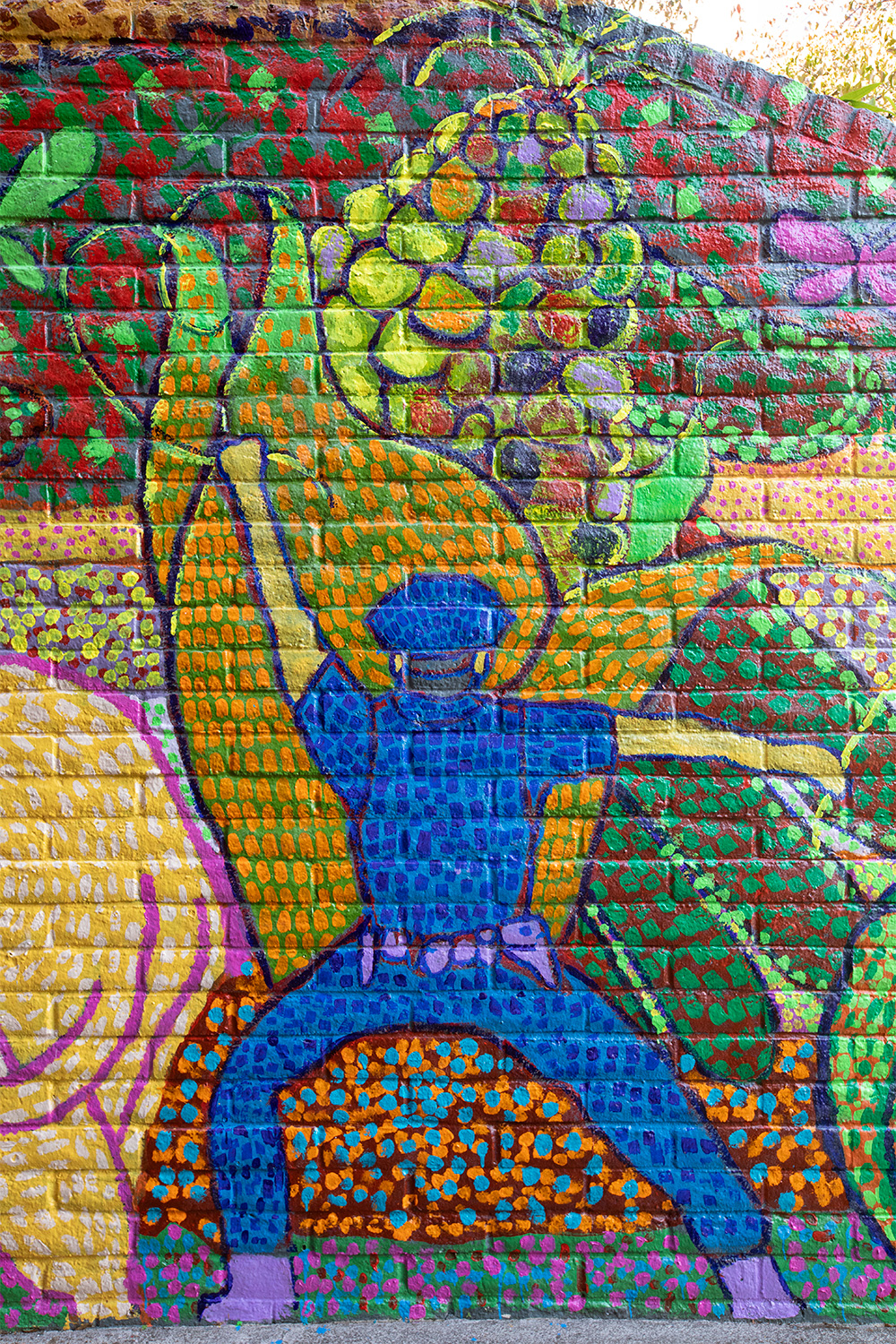The mural’s motifs include monarchs and music notes, women tending to harvest and boys with nets as well as two young girls on their knees, arms linked. Its center has a large bald eagle, wings spread, representing power. Its colors blend beautifully.
At the top of the mural is a representation of Mother Earth or an elder, and to the left of that is Charlie Landeros, with a stern face shouting into a bullhorn for justice.
The mural, titled “Fibers of History,” recently finished by artist Rodolfo Redstone Serna of Portland, is displayed on the east end of West Park Street in downtown Eugene, right behind where Lane County Farmers Market sets up its booths. It is the product of a partnership with Lane Arts Council and the city of Eugene in conjunction with Fiesta Cultural.
It deserves to be seen in historical context on a fall morning, when the sun shines a direct light on the rainbow colors. The mural shows the elegance, pride and humanity of Latinx culture, its simplicity inherent in all cultures. It also deserves to be seen in the present context, because the circumstances surrounding this mural, and Landeros’ place in it, are still tender.
Landeros, 30 years old, was shot in the head and killed by Eugene police on the morning of Jan. 11, 2019, just outside the main doors of Cascade Middle School.
There had been a custody dispute and tension between Landeros and an ex-wife. Outside the school’s front doors that morning there was a scuffle between Landeros and officer Aaron Johns. Landeros pulled out a 9 mm handgun (Landeros was a founder of a group called Community Armed Self-Defense) and pointed it at officer Steve Timm. Landeros fired two shots, but missed. Timm returned fire with the fatal shot.
The body cams that Timm and Johns had on — and later released by the District Attorney’s Office — are less than 30 seconds of terror, all the more so because children were nearby. Patty Perlow, the Lane County district attorney, noted that the incident showed “no clearer circumstance that the use of deadly force is justified than this.”
Landeros’s brother and other immediate family members firmly disagreed. Lauren Regan, an attorney for the Civil Liberties Defense Center who represented the Landeros family, countered in a later press release that while the situation was delicate for police, “We also know that people of color are disproportionately the victims of police violence. We know that Charlie, as an activist against police brutality and a descendant of Mexican and Filipino parents, was aware of this.”
Less than two years later stands the mural on West Park Street, with permission from members of Landeros’ immediate family.
“For me it’s about raising awareness,” the 46-year-old Serna explains from his home in Portland. “The Creator wanted me to do this thing. I want to grow. I want to grow on both sides. There are so many perspectives to this. There’s still more story to Charlie. This is a conversation needing to be had.
“It’s about the human experience,” he adds. “It’s a piece that’s more about unity.”
Serna runs Redstone Collective in Portland, a nonprofit that seeks to teach art to various communities. It has a foothold in the Multnomah County Juvenile Detention Center, among other places.
Serna notes that from a young age, growing up in Chicago “I didn’t see myself represented” in art. He seeks to correct that and has, with community involvement, left studio work and been painting murals for more than a decade. “I have a knack for this work,” he says.
Yet the mural at the West Park Street site seems to have been a surprise to some in Eugene. There’s been the predictable, yet curious, blowback from Chris Skinner, chief of the Eugene Police Department.
Skinner, in a statement earlier this month, was upset in part with a depiction of a police officer in the lower right of the mural, arms outstretched, with what many believe to be a pig sitting next to him.
“Some images in the mural,” he writes, “… feel very divisive and do not seem to be in alignment with the goal of bringing community together and building trust with the public safety professionals that serve the community every day.”
Serna explains that the officer in the mural — generic and not a depiction of EPD officers, in particular — is reaching to pull an ear of corn, a cultural staple of the Latinx and Indigenous communities. The image to the left of the officer is not of a pig but of a calla lily flower.
Stacey Ray, interim executive director of Lane Arts Council, and Laura Hammond of the City Manager’s office, back up Serna’s assertions — though Hammond, in an email to Eugene Weekly, notes,“We acknowledge that we have work to do to improve our process and communication to avoid these unintended consequences.”
Serna is aware of the criticism but not worried about it.
“It was going like any other project,” he says. “People are moved by my work, and Eugene was invested, then this happens. Are you going to go back on this?”
He adds, “I can’t be too surprised at what happened in Eugene. The final product doesn’t belong to me. It belongs to the community. That’s why I didn’t sign it.”
“Fibers of History” is beautiful, even if not all of the history it depicts is not, and it deserves to be seen for the art that it is and in the context in which it was painted.
This story has been updated.

